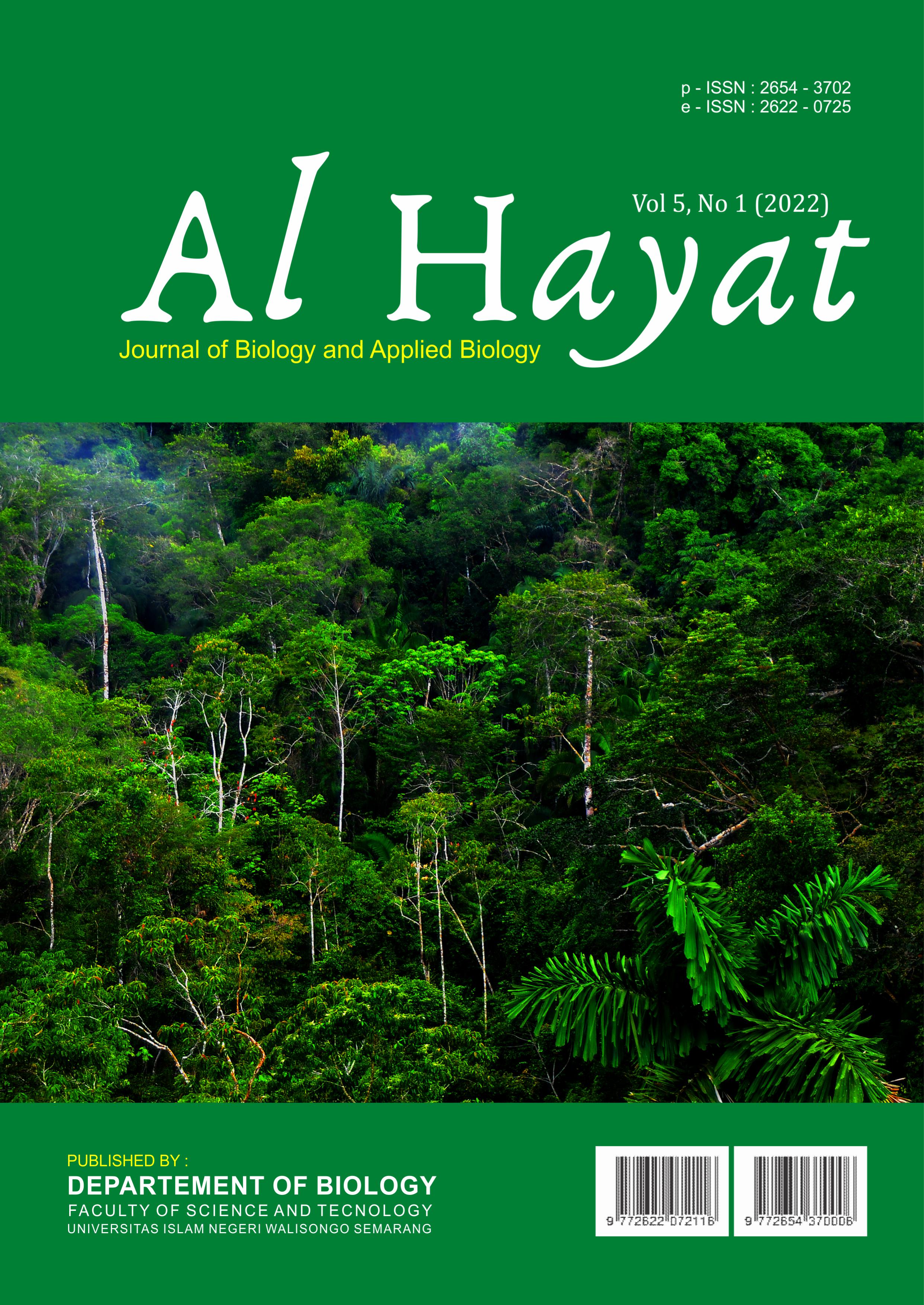Plant Diversity and Potentials in Campus UIN Walisongo Semarang
Main Article Content
Abstract
Downloads
Article Details
The copyright of the received article shall be assigned to the journal as the publisher of the journal. The intended copyright includes the right to publish the article in various forms (including reprints). The journal maintains the publishing rights to the published articles. Authors are allowed to use their articles for any legal purposes deemed necessary without written permission from the journal with an acknowledgment of initial publication to this journal.
The work under license Creative Commons Attribution-ShareAlike 4.0 International License.
References
Akbar A. 2021. Penggunaan dan Nilai Ekonomi dari Tanaman Aglaonema sp. di Kalangan Pedagang Tanaman Hias Sekitar Cengkareng dan Pulo Gadung. Jurnal Bios Logos 11(2)Agustus 2021: 122-128.
Backer CA & Bakhuizen van den Brink RC. 1963. Flora of Java. Volume ke–1,2,3. Groningen (NL): NVP Noordhoff.
Dani BYD, Wahidah BF, Syaifudin A. 2019. Etnobotani Tanaman Kelor (Moringa oleifera Lam.) di Desa Kedungbulus Gembong Pati. Al-Hayat: Journal of Biology and Applied Biology 2(2), 44-52.
Dash GK, Abdullah MS, Yahaya R. 2015. Traditional uses, phytochemical and pharmacological aspects of Emilia sonchifolia (L.) DC. International Journal of Research in Ayurveda and Pharmacy 6(4):551-556.
Karmila K, Nuryanti S. 2021. Analysis of Vitamin C in Rambusa Fruit (Passiflora foetida L.). Media Eksakta 17(1):46-51.
Khasanah RAN, Kusumarini N. 2021. The Morphological and Anatomical Studies of The Aerial Parts of Abroma augusta L. from Semarang. Biodjati 6(2): 222-234.
Malik K, Ahmad M, Bussmann RW, Tariq A, Ullah R, Alqahtani AS, Shahat AA, Rashid N, Zafar M, Sultana S, Shah SN. 2018. Ethnobotany of Anti-hypertensive Plants Used in Northern Pakistan. Frontiers in Pharmacology 9(Juli 2018):789.
Mahfut, Handayani TT, Wahyuningsih S, Sukimin. 2021. Identification of Dendrobium (Orchidaceae) in Liwa Botanical Garden Based on Leaf Morphological Characters. Journal of Tropical Biodiversity and Biotechnology. 6(1): 1-6.
Munasinghe MAAK, Abeysena C, Yaddehige IS, Vidanapathirana T, Piyumal KPB. 2011. Blood Sugar Lowering Effect of Coccinia grandis (L.) J. Voigt:Path for a New Drug for Diabetes Mellitus. Experimental Diabetes Research (2011):1-4.
Munjal K, Kashyap R. 2015. Bamboo Fiber: An Approach toward Sustainable Development. International Journal of Science and Research (IJSR) 4(4): 1080-1083.
Mutaqin AZ, Kurniadie D, Iskandar J, Nurzaman M, Partasasmita R. 2020. Ethnobotany of suweg, Amorphophallus paeoniifolius: Utilization and cultivation in West Java, Indonesia. Biodiversitas Journal of Biological Diversity 21(4) March 2020: 546-555.
Quattrocchi U. 2012. CRC world dictionary of medicinal and poisonous plants: common names, scientific names, eponyms, synonyms, and etymology (Five Volume Set). New York: CRC Press.
Rachie KO. 1981. Tropical legumes: resources for the future. Washington D.C.: National Academy of Science.
Rahayu M, Rustiami H. 2017. Etnobotani Masyarakat Samawa Pulau Sumbawa. Scripta Biologica 4 (4): 235–245.
Rifai MA. 1973. Kode Internasional Tatanama Tumbuh-Tumbuhan. Bogor: Herbarium Bogoriense LIPI.
Rugayah, Widjaja EA, Praptiwi. 2004. Pedoman Pengumpulan Data Keanekaragaman Flora. Bogor: Pusat Penelitian Biologi LIPI.
Sanoussi F, Ahissou H, Dansi M, Hounkonnou B, Agre AP, Dansi A. 2015. Ethnobotanical investigation of three traditional leafy vegetables [Alternanthera sessilis (L.) DC. Bidens pilosa L. Launaea taraxacifolia Willd.] widely consumed in southern and central Benin. Journal of Biodiversity and Environmental Sciences 6(2):187-198.
Sholichah L, Alfidhdhoh D. 2020. Etnobotani Tumbuhan Liar sebagai Sumber Pangan di Dusun Mendiro, Kecamatan Wonosalam, Jombang. Jurnal Ilmu Pertanian Indonesia (JIPI), Januari 2020: 111-117.
Simpson, M G. (2010). Plant systematics. California: Elsevier Academic Press.
Suerni Endang, Alwi Muhammad and Guli Musjaya M. 2013. Uji Daya Hambat Ekstrak Buah Nanas (Ananas comosus L. Merr.), Salak (Salacca edulis Reinw.) dan Mangga Kweni (Mangifera odorata Griff.) terhadap Daya Hambat Staphylococcus aureus. Biocelebes 7(1):35-47.
Taufiq I. 2020. Laporan Rektor Tahun 2019. Hlm 1-100.
Tjitrosoedirdjo SS, Chikmawati T. 2014. Sejarah Klasifikasi dan Perkembangan Taksonomi Tumbuhan dalam Modul 1 Taksonomi Tumbuhan Tinggi. Universitas Terbuka: Jakarta.
Wahidah BF, Husain F. 2018. Etnobotani Tumbuhan Obat Yang Dimanfaatkan Oleh Masyarakat Desa Samata Kecamatan Somba Opu Kabupaten Gowa Sulawesi Selatan. Life Science. Journal of Biology 7(2):56-65.

